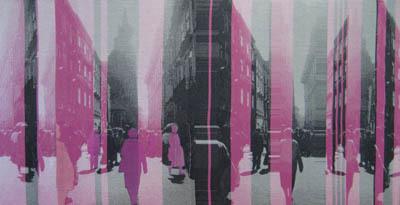User:Vera/graduation/Textiles as Screen
Who controls the past controls the future. Who controls the present controls the past. - George Orwell[1]
They art of showing, not knowing
Contents
Abstract
It Doesn’t exist, only in my head a. But something what we don’t see can’t be made? Maybe we can see it but not aware of it anymore it was existing. A discard craft in relation to technology. This craft is weaving a technology on his one. It’s counting, seeing, time consuming, storytelling, on social and curtails levels. But not like a screen where we like to read our information form. Even it says nothing we are involved with the screen. This is the reason I want to investigate the working of a screen in weaving piece, how could show and hide at the same time. A screen how shows only what you want to show. A screen how is multifunctional, can be in ever direction, and is a piece of our life’s. Like George Orwell quote, If you cant hold the past it will be fade out and only know in your existence, don’t know how it works anymore the future will. It is not about showing on the screen but showing the craft as a screen. The timeless message of the human though a screen of textiles how wants to disappear.
Intro
In the past years we learn at general theory the quote of Marshall McLuhan (1964) – "The medium is the message" – [2] and have to learn how he saw the message would transmit and in with case the medium influences the message. There was never a moment that we speak about links between the innovation in weaving and today's computer age. The message is not about what there is behind but only in what you see, in a digital based age.
Robin Kang, Squiggle Core, Jacquard Woven
[3]
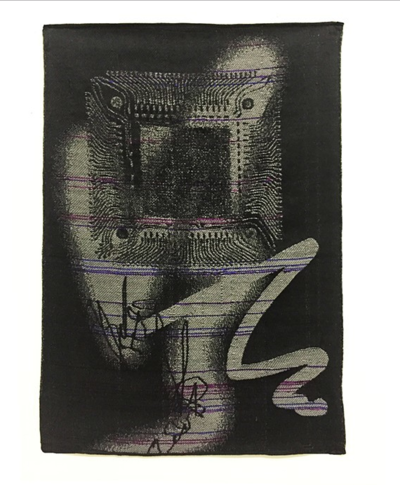
After four years of a art academy I learn a lot of my perspective as a graphic designer how to give message in form as ‘it could be everything’ but I never consider to do it in textiles. some way I always had a weak for textiles. The softness, patroness and colours and the story’s behind it. This weakness for textiles create also a obsession with it. How it is created and the creation behind it, I want to know, and I have to know. It is a complex system that we forget this days, even when we as a graphic designer work with this for every day. We know how to work with machines, where the typography come’s from to design patrons, posters enz. But skip the part of textile even as non-European art. We as a designer forget the communication part of textiles in this world without language. We started to remember things when we storage in our memory’s, in our heads or in a book, of how computers started with core memory weaving the barring’s into zero’s and one’s.
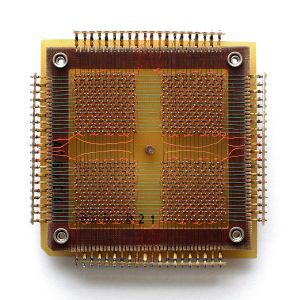
weaving memory core
A 32 x 32 core memory plane storing 1024 bits of data.
[4]
In this part it Feld forgotten that counting systems also a thing is where we as society started with, even without we had a language. This counting system credit not based on money, computer based or other things just by weaving patrons. Weaving was a part of the society’s screen. Showing what they had to tell by only looking to the weft textiles. A social and cultural system how’s recording by counting and composing textiles.
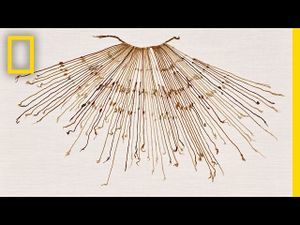
Threads That Speak: How The Inca Used Strings to Communicate
[5]
We don’t see it anymore because it is fade out in our screen based world. We don’t needed textiles anymore as a media or medium to express ourselves.
But I think this is just the part where I as a designer some obsession has with. Why do we see textiles with a focus on weaving as a media or technology? And for a graphic designer why I don’t design this patron anymore as a screen? And why should I always make screen based work in the end? I like to combination my obsession for this forgotten medium with the medium I always work it. The screen. The textiles as a screen.
Note: if we forgot the message we don’t know how to work with the medium. So if we don’t use textiles for the suppose to be we might have forgot how to work with it. So the massage is the medium. And my massage is why do we forgot this medium. I don’t want to show on it but with it. The textile themselves is de hidden medium.
Subject
Subject: Weaving, (anti-)Media, technology, craftwork, social memory
Question
Can I Make a Screen of textiles?
Why
To investigate the break between historic and contemporary textiles in relation with technology. A historic textile how we used as a screen for communication, a tool how not only designers work with but also a big part of the world run on it, on a screen. We don’t take textiles not so seriously anymore. And why?
“we take technology very seriously is because we believe in technology”
Science is stable and therefore reassuring in a world where everything continually changes. Science is verifiable, reliable, and thus worthy of our trust.’ - Lianne Polinder[6]
And textiles can’t be a part of this technology? We starter counting and systems based on weaving with a good design? So a textile could than not be a screen? Or we never consider to use it as a kind of screen? It told us for century’s what there was happening in the world and now we discard it? but only thing with the the technology is it can’t be controlled anymore, not how we did before when we know how we have to deal with complex systems like textiles how told us,
LCD screen of textiles without technology. Lianne Polinder[7]
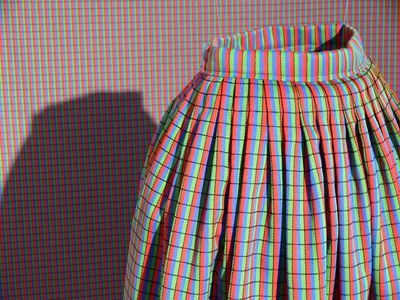
We like to build our experience and knowledge on facts of the technology and what we see on a screen. And why? It it so useful, also like a screen. We don’t want to investigate with something how isn’t default with science. And science = technology. Art = weaving = cultural knowledge.
Technology doesn’t always capture the human side of language, and that is how things are said. And without it, language is being reduced to meaningless words.Francesca Rodrigues
We might forget how big the influents was of textiles art in history and how we discard it out our life’s. we use a screen now to see and to show, get our knowledge off and not our cultural society by seeing textiles. The textiles how are a Social change, communication in cross space time, first global commination system Not how it looks like but also how it feels, how it is made, where the colours are from, and how we use it in our systems.
We Compliantly be forgotten because we don’t make it anymore as Textiles as having a medium on the one site and expressing ourselves de message on the other. I want to make this Screen of textiles to make a combination of the craft work form the history in a contemporary narrative as a graphic designer. How will I use textiles as a screen as a graphic designer? How I tell human their message will disappear in textiles?
There is a common narrative in this screen as a textile. I don’t know if it is possible but I know it will a big investigation to explore textiles on artist is trained to understand the language of color by sight, she believed the tactile sense – our sense of touch – must be trained to speak the language of structure.
Examples
Francesca Capone: Writing in Threads
[8]
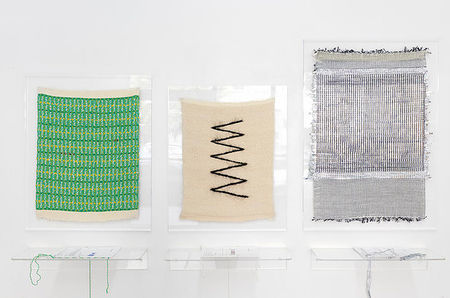
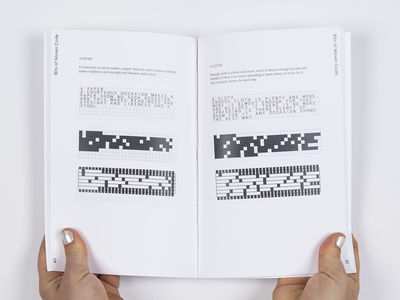
Richard Vijgen'
http://www.wifitapestry.com/
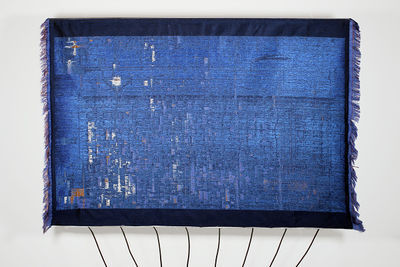 WifiTapestry is a dynamic wall hanging that visualises the wireless activity of a space.
The tapestry visualises the ever changing "landscape" of radio frequencies around us.
The invisible signals from Cellphones,
printers and all kinds of smart devices leave an imprint as they try to negotiate available wireless channels.
WifiTapestry is a dynamic wall hanging that visualises the wireless activity of a space.
The tapestry visualises the ever changing "landscape" of radio frequencies around us.
The invisible signals from Cellphones,
printers and all kinds of smart devices leave an imprint as they try to negotiate available wireless channels.
A controller listens to all traffic across 13 channels of the 2.4GHz WiFi Spectrum.
Whenever data is transmitted on a channel, the controller sends a current to an array of thermal elements embedded in the tapestry,
converting data into heat and activating a thermochromic yarn woven into the tapestry. Like a Shroud of Turin,
streams of data transmitted through a space appear as visual traces from an invisible dimension that gradually form and dissolve.
Maggie Orth http://www.maggieorth.com/art_100EAYears.html
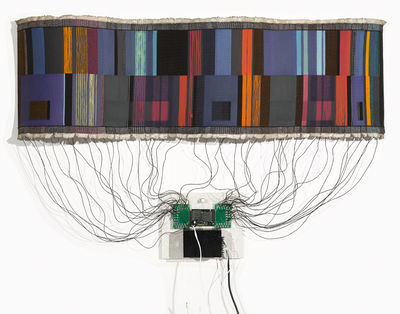
The title of 100 Electronic Art Years refers to the ambiguous lifetime of color-change textiles,
and all electronic art. All art fails. All electronic art fails.
The question is how, and with what result?
Anne-Marie http://emeteuz.com/woven-signals/
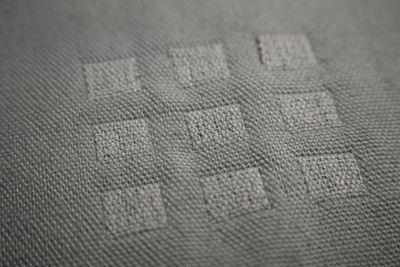
Woven Signals aims at fusing new technologies with the fabrication techniques characteristic of traditional textile design to create functional fibers and integrated textiles, specially a woven display.
The textile is woven with a custom-made thermochromic cotton yarn spun with conductive wire. Designed patterns incorporate channels for low-power current. When activated, the generated resistive heat catalyzes the dyed fibers to change color and reveal a hidden, programmatically-controlled content.
Woven Signals is inspired by the mutually informative histories of textiles and communications, and aims to investigate a fiber's ability to transmit information and emotion through visual and tactile interactions.
From long time ago till now
Life on the Screen by Sherry Trukle [9] Richard Tuttle [10]
By seeing the lecture of Ganaële Langlois - Textiles as Anti-Media[11], I was intergraded by the fact shy told my because we don’t make textiles anymore. Not how we have to be.
Maybe it is for you not so imported but is has to be!
If we go though the past and textiles are not only a European form of art and message, this textiles message is all over the world. Every where in every generation. It can be one of the oldest forms of art in human civilization. We don’t call it a message because we are not aware about textile is also a form of telling, feeling, communicate. It looks like in 2018 we forget the power of textile. And seeing this only as a history and use only words an alphabets and paintings as a common story.
It was not only in clothing was still the dominant type of fiber art, it tells stories of many years.
Without having a digital medium in between. On some reason it felt we forget this kind of languages.
I already shows you a how the inca’s had a counting system. Textile as medium. The truth carrier of a message. Sometimes the hidden message al over the world.
But yaeh The Industrial Revolution was a turning point for textiles, even in the book of Walter Benjamin - the work of art in the age of mechanical reproduction. With the invention of the cotton gin, spinning jenny, and power loom, creating fabric was now automated and could be produced on a massive scale. Textiles were not just for the wealthy anymore; as prices dropped, they were available to more of society. It also meant that these materials were not as precious, and creative people could experiment with them in previously unseen ways.
We create of our textile carries a fast fashion industry. But instead of textiles as a carrier of social economic information. Is change the human and can create ourselves something where we come from, where we believe in.
The rich history of textiles has laid the groundwork for contemporary creative. In modern times, the terms fiber art or textile art generally describe textile-based objects that have no intended use. Although this realm has previously been seen as “women’s work,” artists—particularly female artists in the 1960s and 70s—started to reclaim the field and elevate it into high art.
start in tapestry what was a form of art. Some how I feel some strong relation between the tapestry and the digital mediums that we used now. The story’s what we make on our Instagram and how we can see the story’s in the tapestry. One the Instagram is sort story and the tapestry is an for every take time story.
The Textiles as carrier is not a fast medium, Don’t fit in the ideal message of how we create our story’s. But it is more a anti-media between, why should everything fast? Why do have the save every message? And can we show our self and hide it ate the same time? Yes in textiles. Some fiber softness in revolution we can show some revolution in our behaviour.
t-shirt champagne anti-trump:
Textile have the power to be flexible, to have a craftsmanship thought generations, have a feeling, story telling in human, beanery code to create the textile, the nature where we live in to create colour and some spiritual novae, a cross county, and a way to communicate with others without languages.
As a graphic designer how lonely look to from where the alphabet stated, I didn’t know the the story of textiles in communication. There are not only forms, colours, and patterns, there are collaboration between ever boundary in the human and nature aspect of communicating.
Using textile as a computer interface. Textiles as a medium of his one.
Keep olds techniques back other wise we became victims of the industrialisation.
Can I bring back this textiles medium in a digital age as a graphic designer? It is pretty hard to find information though leagues as textiles in books, because the forgot the latterly the hole textile as a form of communicate. And why? we don’t see it anymore as useful in the making process, we don’t make it anymore. We use the industrialisation of big machines to create everything for us. The distance is to big to understand to create awareness of the fact textile is a medium to make revolution, progress, war, feminism, personality, identity, history.
The textiles as a screen do displaying the forgotten ness of our collaboration in textiles.
We can hide it, we can create different shape in it, take it outside, it is never the same, will will lose the controlled over the screen by touching it in sted of losing te control of forgotten how create to make a textile. In the end we don’t know, and the screen will don’t know either, it was for a short moment to create this.
There is only a medium but know message anymore to see. But a awareness of the long term of how we forgot that textile shows how we are and what we displaying. It doesn’t record what textiles and also computer doing. It will be losing the recording. And and as a plain face, with colours as the clouds. It only recording the weaving patron, you see noting but the process of making the thread, desys the thread, create a patrons how fits in our human mind recording the revolution of creating a binary system of connately counting. It is not a computer, it is not nature, it’s human system how never will be perfect.
To come back to be a composer as a graphic designer how works the most time with texts and forms.
I create images. But I don’t work with textiles even if they are important to me. The true carrier.
Textiles are the carrier of them self not the human in it. Showing the textile how will be chancing by touching off the human will change the the message of the human.
The screen influents our behaviour, chancing our perspectives, carries our image around.
The death of textiles
Experiments
Relation thought how to make it. Because I investigate this break between the historical function of weaving and the digitalisation of weaving. I have to make this ‘screen’ on an old weaving loom. I can tell you I’m not sure if there is time enough to make this hole project. For my is it very imported to make this on the old loom to understand the hole weaving part, it cost time time to understand. The experiments are based pure on Process and Research. So I had the idea to create a screen it has to be on and off. Also in colours. This themochromic colours sounds for my as a start to created this screen. When I read this from Maggie orth:The failing part is big, even as Maggie ort sad with 100 Electronic Art Years, 2009The title of 100 Electronic Art Years refers to the ambiguous lifetime of color-change textiles, and all electronic art. All art fails. All electronic art fails. The question is how, and with what result? I stared with a idea of making a screen of textiles, because I was wondering why it didn’t have it when we live now. The Technology is there, the materials are there, but the screen is not there. But in my reaches it giving a change, a change of a old forgotten craft how was given by knowing and not by language. A different perspective for a graphic designer where I work everyday with. It is not only a screen anyone but more but change in my one coding system to look though colours. The coding system are the colours for now. By doing the experiment and doing the research there change one big thing, and this is the subject how stared clear grows to a super open subject with a lot of splinter fields, because I found answers on how to make it but more and more possibility’s how to created. The subject is not only weaving, dyeing, counting, coding but also social, history, perspectives, arguments, digital, non-digital, science. It’s not I don’t want to choose but I will do my experiments by are pure based on my one invention en curiosity On the Short Life of Color-Change Textiles in the end—all art fails. This world and the works of human beings are ultimately transient. My color-change textiles are just an accelerated metaphor--an amplification--the human struggle for permanence and the ephemeral quality of life. – Maggie Ort Maybe it will all fail - for my idea of research is: onderzoeken is uitsluiten (sorry for doing this in Dutch) but I couldn’t give a proper translation on it. The experiments are based on a textile screen vison of making this screen out of textiles. So I use a colour based screen as example. And try to dye the threads in 4 colour types. Design a patron how want to intergrade to a screen version and looks to thechnogey how shows the message.
Dyes
Is not on they internet how to dye with this thermochimic pigments. I just order some pigments from the US. On https://solarcolordust.com/ it’s some vague internet website but they had also a Instagram account so I give it a change.
Only I did some dyes before but that was special made for textiles, I never dye something from pure pigments. Also the googling part ends on nothing only people how it succeeds, ore print it with silkscreen techniques. But then it is on the textiles not in the textiles.
I emailed Richard Vijgen with his project Wi-Fi tapestry, and till my surprise I get really soon an email back with al his information. He orders the thermochimic yarn from alibaba. (even his project is super cool, it is cheating) he told my he didn’t know how to dye it with pigments and the textile museum also didn’t know. And the dyeing part more a project on his one.
But I will to do it on my one and dye it, maybe a bit to ambitious. The reason is u can buy over the hole word 2 colour as thread. From pink to whit and form bleu to white. Not where was I looking for a screen need colours and to go off al to the same colour.
In this dyeing process I ask advise of Marit form the fabric station and colour lab.
See also didn’t know. After a lot of didn’t knows I decide to do every possible option to find a solution dyes the threads.
Cold Water + pigments = separate
Warm Water + pigments = separate
Cold Water + vinegar + pigments = separate and grainy
Warm Water + vinegar + pigments = separate and grainy
Pigments + plain cotton + rub in = not constant and spotty
Pigments + cold wet plain cotton + rub in = not constant and spotty
Warm Water + pigment + Binder for silkscreen = grainy but give some colour
Warm water + pigment + Arabic gom = separate and grainy
Enz enz. It was difficult to find some good solution, but I had in my mind form grey of black to colour to represent the screen.
http://courses.media.mit.edu/2011fall/mass62/index.html%3Fp=354.html
http://emeteuzblog.weebly.com/using-thermochromic-pigments.html
Acid Dyes- Are a class of dyes most commonly used for dying wool or protein fibers. Acid dyes are thought to fix to fibers by hydrogen bonding, Van der Waals forces and ionic bonding. They are normally sold as the sodium salt therefore they are in solution anionic. Protein fibers and synthetic Nylon fibers contain many “cationic” sites therefore there is an attraction of anionic dye molecule to a cationic site on the fiber. The strength of this bond is related to the desire/ chemistry of the dye to remain dissolved in water over fixation to the fiber.
Than I found something of acid- dyes and knows the fault, I used is as a natural dye process but because it it a Acid pigment I have to dye is as a Acid Dyes pigment. Also I used cotton al the time, so I decide to go for pure synthetic threads. And I needed a medium the blend the pigments perfectly into it.
By excaldensial founding a medium beads for alryl I’ii give it a try, and it works! Perfectly.
More of the process is in this link = http://digitalcraft.wdka.nl/wiki/User:Vera/graduation/Textile_experiments
Note: if you want to dye something you have to think about the, it it a natruall dye of Acid dye, is the HP- of the water ok? Otherwise nutrallise it with sel, choose for a warm or cold bath bases on the pigemnas, or inks you have. For colour fixation use a vinger, soda or lemon jus. (it can also with chemicals, but I don’t like that)
Weaving
I know how to weaving and how it works, I learned this at my internship by Simone Post. I just saw it as a thing for making plaids and home wear stuff. But for now, till this day it is no just a weaving peace anymore. It is, a story, coding, art, I think it is everything on this moment to tell. You don’t see it anymore, because we not aware. If we want to know something we look at the screen. The screen knows the answers on life. The break of how we interstate textiles and how we make textiles are so big. The reason is every one ask my but what are you goanna make, this is the hole point. It’s already make something. The outcome is the end result; I think by weaving the process the result of the outcome. The outcome holds this information for ages so you have to be knowing what you want to show in the beginning. So I just stared a screen how can’t hold information for ages, only for a minute. The patron what I want to make have to be related to the screen, for creating this I actually needed a Industrial weaving machine, but I just created on a handloom. The weaving part is counting, creating, knowledge, making. Drawing patron on a 16 shaft based loom. The experiments what I did is based on o lot of drawings to see what I want to make. To make a screen I just weft some examples on a cardboard en an 8 shaft loom: 1. 2. 3. 4. 5. and make drawings how it have to look 1. 2. 3. 4. 5.
Heating / cooling
Heating / cooling This part cost also a lot of time, when you look at e-textiles you see a lot of conductive threads. So my first thoughts were to do it with this. I used, Conductive threads: Isolated coper conductive thread uninsulated twisted copper wire 2 plyers steeliness conductive thread 4 plyers steeliness conductive thread Copper tape heating pads Peltier element The Conductive threads work perfectly for making a pieces how are hides the threads, only this threads take a lot of power, so much it it not save to work with. And the costs are quite high.
Results
Conclusion
The Question of can I make a screen of textile? Change in argument why do we use textiles anymore as a screen? The thing what I will make in the is not so imported anymore. The steps behind it are is what it makes. The history of a weaving piece how incredible it was they could make al these things. The hidden things about this textile are to big to argument en investigate in one document. I think yes it it possible to created some screen in textiles they already did it in the past. The screen started with showing it on the textile. This was maybe the mistake to created something with technology but the weaving becoming their theology on themes selves. My end protect is the shows the message of the world for a minute, if we go for the fast living where we use screens as medium we will forget the message. I don’t want to show on a screen, you the human have to show form screen to screen trough a forgotten medium. The message is not anyone can I make of can I show; can I know how it works.
People ask my what do you want to show? if you have a screen I don’t ask you the same question right? You know what you want to see.
links
Most important document:
http://artfordorks.com/pubs/16_CHI_Ebb.pdf
http://www.marieledendal.se/wp-content/uploads/2016/01/Marie-Ledendal-PhD-thesis_Thermochromic-textiles-and-sunlight-activating-systems_low-res.pdf
http://hb.diva-portal.org/smash/get/diva2:876942/FULLTEXT01.pdf
http://www.diffus.dk/publi-conf/paper_ny.pdf
http://www.xslabs.net/color-change/
first googleing:
http://infosthetics.com/archives/2006/09/reach_textile_patterns.html
https://vimeo.com/138025527
contacts:
http://v2.nl/lab/blog/beta-textiles
https://www.richardvijgen.nl/#tapestry
http://www.adriaanwormgoor.nl/
inspiration:
http://transmaterial.net/chromosonic/
http://ejtech.cc/
http://etextile-summercamp.org/swatch-exchange/
https://www.richardvijgen.nl/#tapestry
http://www.fiberworks-pcw.com/mac.html
http://fiberarts.org/directories/links/software.html
https://docs.google.com/document/d/1R0k7gYX3Vk06Zw4eOUB2YyAvQC9KuRgtEO3gt5y8sW8/edit?pli=1
http://www.jingwen-zhu.com/blog/dynamic-textiles
conductive thread:
http://www.instructables.com/id/Embroidered-Fabric-Speaker/
Nichrome wires
sales conductive thread:
https://www.bart-francis.be/index.php?item=etextile-en-co&action=page&group_id=128&lang=NL
http://www.elektrisola.com/enamelled-wire/enamelled-wire-types/iec/europe.html
http://www.tibtech.com/smartshop/index.php?id_product=121&controller=product&id_lang=1
http://jacobs-online.biz/nichrome_wire.htm
sales pigments:
https://prochemicalanddye.net/dyes/dyes-for-wool-silk-nylon-and-other-animal-fibers.html/
https://www.sfxc.co.uk/products/liquid-crystal-inks
Links:
https://penelope.hypotheses.org/
http://kairotic.org/
https://www.richardvijgen.nl/#tapestry
http://www.gemmamaylatham.co.uk/blog/
http://hb.diva-portal.org/smash/get/diva2:876940/FULLTEXT01
http://kit-of-no-parts.at/?p=734
http://openmaterials.org/category/research/
http://kit-of-no-parts.at/
http://etextile-summercamp.org/swatch-exchange/
http://artfordorks.com/2016/04/ebb/
https://www.instagram.com/savagetextiles/
http://etextile-summercamp.org/swatch-exchange/wp-content/uploads/2014/07/SwatchBookExchange2014_PDF_DS.pdf
http://www.design-research-lab.org/persons/katharina-bredies/
http://etextilelounge.com/
http://www.weavesbywendy.com/honeycomb.html
http://nerding.at/course/101/?p=1281
http://www.marieledendal.se/sv/inlagg/thermochromich-textiles-and-photovoltaics/
https://luxxnatura.wordpress.com/
http://courses.media.mit.edu/2011fall/mass62/index.html%3Fp=354.html
http://www.maggieorth.com/art_100EAYears.html
http://goughlui.com/2012/12/27/pixel-pitch-visual-comparison/
https://www.ellumiglow.com/electroluminescence/vynel
References
- ↑ George Orwell, Nineteen Eighty-Four, Secker & Warburg, 8 June 1949 [[1]]
- ↑ Marshall McLuhan: The medium is the message, 1964
- ↑ Robin Kang, 2015, Hand Jacquard Woven Cotton and Chenille[2]
- ↑ 32 x 32 core memory, plane storing 1024 bits of data[3]
- ↑ Threads That Speak: How The Inca Used Strings to Communicate,National Geographic, Published on Mar 10, 2017[4]
- ↑ Lianne Polinder, Technomimicry,An Essay on Technology, Ornament and Function, 2014[5]
- ↑ Lianne Polinder, 2014[6]
- ↑ Francesca Capone: Writing in Threads, Francesca Capone, Solo exhibition at 99c Plus Gallery, Brooklyn, NY, 2015 [[7]
- ↑ Sherry Trukle, Life on the Screen, Simon & Schuster, 1995
- ↑ http://inhalemag.com/richard-tuttle-tate-modern-2/ I Don’t Know . The Weave of Textile Language 2014
- ↑ https://youtu.be/Vbm5nPY-XBk Ganaële Langlois, Textiles as Anti-Media, ‘Moment of Truth: for a Reasonable Ecology between the Media’,2018
